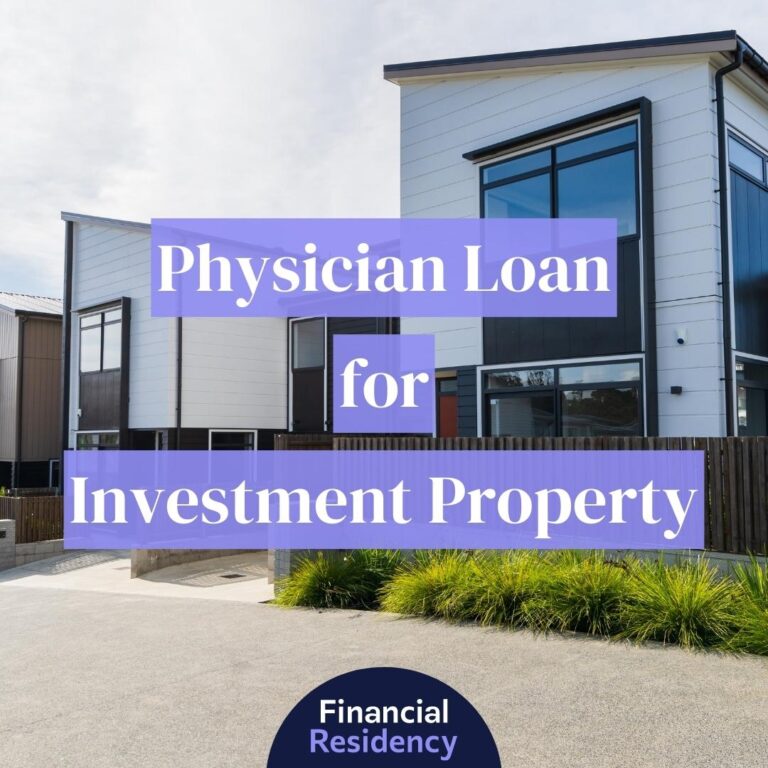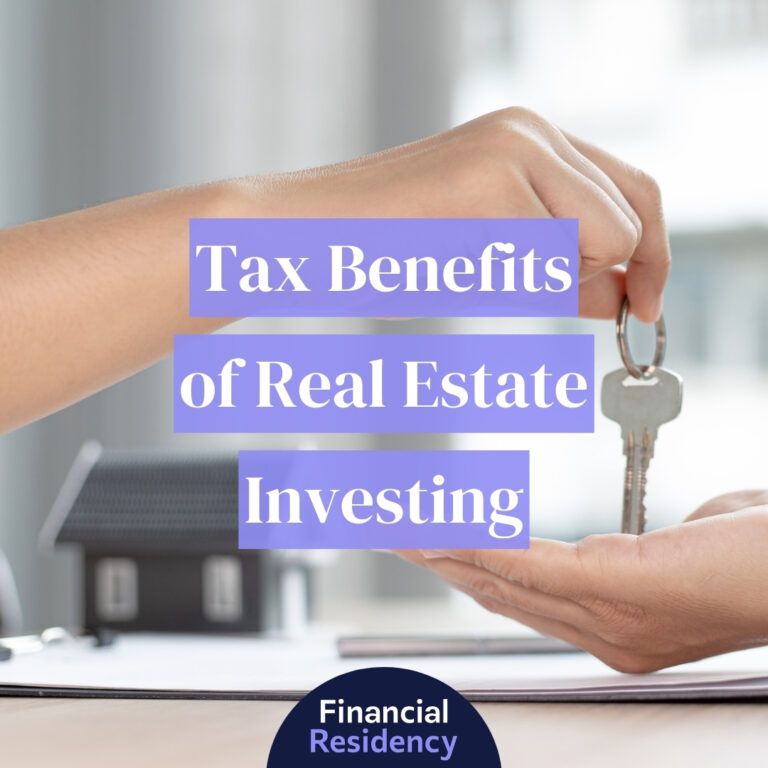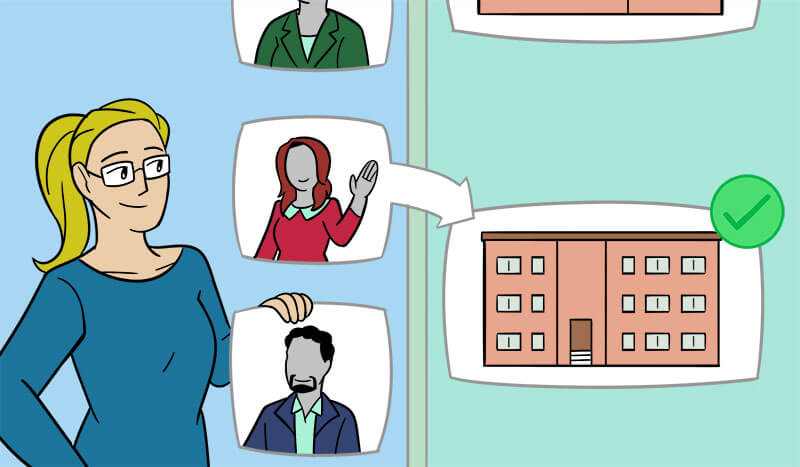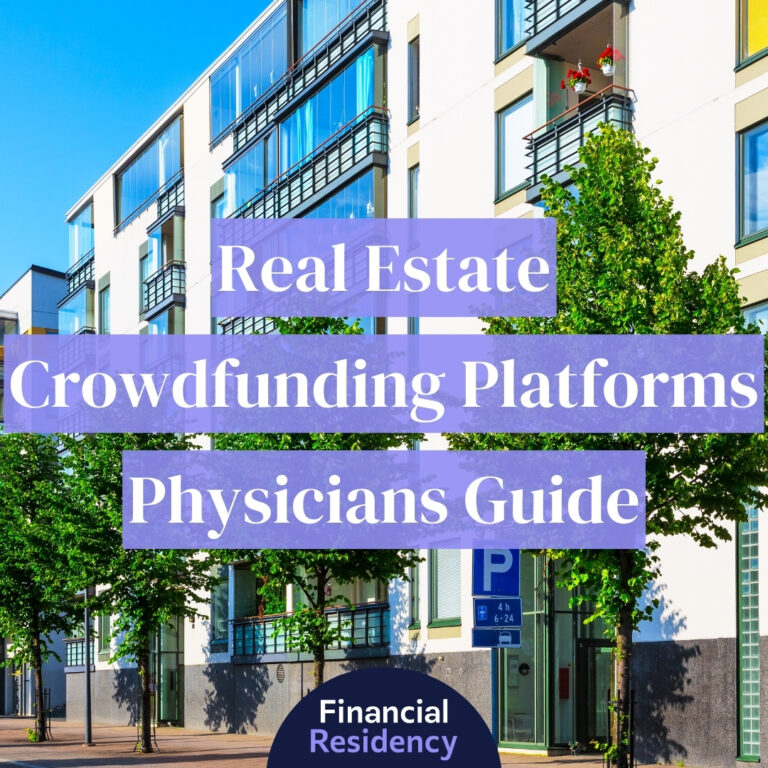So, you’ve decided to invest in single-family homes – congrats! That’s the easy part. Now you have to learn how to carefully evaluate a rental property to purchase.
This can be particularly tricky for first-time investors, especially physicians who may have absolutely no experience in the real estate industry. But fear not, we have you covered.
We’ll show you how to determine if a property is a good rental investment.
6 Steps to Evaluate a Rental Property
Here are the steps involved in vetting and acquiring a single-family home as a buy-and-hold investment:
- Step 1: Refine Your Investment Strategy
- Step 2: Determine Your Budget
- Step 3: Create a Sample “Pro Forma”
- Step 4: Calculate Up-Front Rehab Costs
- Step 5: Crunch the Numbers
- Step 6: Reevaluate Your Price Point
Step 1. Refine Your Investment Strategy
You’ve already decided that you want to invest in single-family rental houses. This decision should be made in the larger context of your investment goals: are you buying single-family rentals for cash flow, appreciation, or both?
There are pros and cons to each investment strategy.
- Investing for cash flow means that you’ll have to cover all expenses (including the mortgage, taxes, interest, maintenance, property management, etc.) prior to earning any income. The income generated above and beyond all expenses is called “net cash flow” and is your profit.
- Investing for appreciation is for people who are buying with the hope that the home increases in value during the holding period, meaning they’ll earn their profit upon sale.
In an ideal situation, a single-family home will have both positive cash flow and appreciation potential. That’s the best of both worlds.
Conversely, investors should be careful not to invest in an SFH for appreciation if that home has a negative cash flow. This is a speculative form of investing that requires the owner to have enough money to cover the balance each month, and there’s no guarantee that the home will ever appreciate in value. This is a highly, highly risky strategy that most are best to avoid.
A condo is not a single-family home and has some unique challenges we won’t address here.
Step 2. Determine Your Budget
It goes without saying that every physician should start with some “guardrails,” or investment parameters, to guide their search for single-family rental opportunities. That typically includes setting a realistic budget. Can you invest $10,000 in a home? $200,000? Or are you looking to invest $1 million or more (maybe in a portfolio of single-family rentals)?
Your budget will influence the size and types of assets you look for, the condition of the home (turn-key vs. in need of renovation), and markets in which to invest.
There are other factors that may influence your budget—we’ll come back to this topic later.
Step 3. Create a Sample “Pro Forma”
Real estate investors often use the term “pro forma,” which is really just fancy industry language for “estimate.”
Most single-family rental pro formas are set up using a spreadsheet like Excel. This estimate will be a valuable tool to guide you through the property selection process. It is the best way to crunch the numbers on properties by doing a side-by-side comparison.
More sophisticated real estate investors might chuckle at the notion of creating a detailed pro forma for the sake of buying a single-family rental.
“Ha! I could run those numbers on the back of an envelope!” you might hear someone say. And that’s true.
Sophisticated investors can usually run the numbers on a single-family home rather easily. But that doesn’t mean you should, especially as a physician who’s putting a chunk of their hard-earned money into their first real estate deal.
Inputs into the Pro Forma, include:
- Purchase price
- Down payment
- Loan amount
- Interest rate
- Amortization
- Closing costs
- Equity required (down payment + closing costs)
- Rent
- Vacancy
- Effective gross income
- Rehab costs
- Operating expenses
- Taxes
- Utilities
- Management fee
- Reserves
- Insurance
Seems like a lot to wrap your head around, doesn’t it? But don’t panic. Once you get a handle on these numbers, it’s really easy to compare properties and analyze whether a deal will be lucrative or not.
How to Estimate Some of These Numbers
Purchase Price
Typically, investors expect a single-family home to spin off at least 1% of its purchase price every month in rent (not to be confused with net revenue). This means a $100,000 house should rent for roughly $1,000 per month. This is just a guide, as other factors (such as expenses) will influence how well a property truly cash flows each month. Don’t be shy about negotiating prices on homes that don’t meet this threshold. The asking price for homes you see listed online, through the MLS or otherwise, is just the starting point. You may be able to get the property at a discount.
Rent
Prospective buyers will want to spend some time researching the local market to get a handle on how much rent they can reasonably expect to charge for a specific property each month. There are many ways to find this information.
You can begin by talking to a broker or property manager, who will take a look at the property’s basic information (square footage, number of bedrooms and bathrooms, property condition, amenities, etc.) and will then compare that information to “comps” in the area.
Comps, or comparable properties, are other rentals that are similar to yours or located in a similar market. A real estate broker or property manager will use comps to help you set a rental rate.
If you have friends in the industry, you can also ask other local landlords and real estate investors what they’re seeing in terms of local rental trends. They can be a great resource not only for setting the price but for understanding whether rents are trending upward or downward in a specific market. Physicians can (and should) do some homework of their own, too. Look for rentals on websites like Zillow, HotPads, and Craigslist.
This will give you a sense of what other people are renting their homes in your market. If your home is bigger, nicer, or has more amenities – you might be able to charge a premium over some of the others. Conversely, if yours doesn’t stack up as well as the comps, you should consider a lower rental rate.
Factors that Influence How Much an SFH Will Rent For:
- Square footage
- Number of bedrooms and baths
- Parking (amount and location, e.g. garage vs. driveway vs. on-street)
- Location/proximity to schools, transit (highways and public transit), and job centers;
- Whether pets are allowed
- Timing (renting in the spring/summer is notoriously easier than renting during the holidays or in the dead of winter)
- Amenities (e.g., back yard, in-home laundry)
- Whether the rental will come furnished or not
- Utilities, both types (e.g. oil vs. gas. vs. electric heat), and whether they are included in the base rental amount or not
Some of these factors will matter to some people more than others. For instance, a person who does not have a pet may not care whether it’s a pet-friendly rental and will not want to pay a premium for that added benefit.
These factors should be considered across the board, even if they do not matter to each individual renter:
Vacancy Rate
A single-family home’s vacancy rate will vary based on the city, local submarket, condition of the home, rental rates, and timing of coming to market. For example, in college towns, most homes lease up for September 1st. If you try to rent a home in February, it might sit vacant for longer (unless you take some action to mitigate vacancy, such as dropping the rental rate). What’s important is that every buyer builds a vacancy estimate into their pro forma. As a rule of thumb, budget at least 5% vacancy. Vacancy might be higher or lower, but over time, it’s rarely 0%. A leasing agent or property manager can provide guidance as to a realistic vacancy rate in the market you’re considering.
Utilities
Utility costs can also vary depending on the location of the property (climate), types of systems, energy source (oil, gas, electric), providers, size of the property and more. Most people factor in heat, electricity, water, and sewer costs. But don’t overlook other utilities, such as garbage collection fees, cable, and internet bills if you plan to offer these services to tenants as an amenity. As a starting point, you can ask the seller of a single-family home you’re interested in buying to give you a detailed history of their utility expenses over the past 1-3 years.
Operating Costs
When investors talk about “operating costs,” they’re using a catch-all term to describe many of the costs associated with operating the property. Utilities are one of those costs. Operating costs also include real estate taxes, rental fees, homeowner’s insurance, management fees, repairs and maintenance (including landscaping, snow removal, and pest control), and other miscellaneous expenses (such as accounting, legal, or marketing fees).
You Can Calculate Some of These Costs by Doing a Bit of Homework
Property Taxes
Property tax data is collected at either the municipal- or county level. You can typically find the amount of the latest tax bill by searching the tax assessor’s online database.
As an alternative, if the information is not available online, most will at least publish the tax rate (or mill rate) which is calculated as a certain dollar amount per $1,000 in assessed value.
Let’s say you’re buying a single-family home assessed for $400,000 and the local mill rate is $12/$1,000 for residential properties.
That would be $12 x $400 = $4,800 per year in taxes.
As a forewarning, it’s important to know that the assessed value will often increase after a sale takes place. Be prepared to budget for a tax bill that is based on your purchase price, not the current assessed value.
Lastly, be sure you’re using the non-owner-occupied residential tax rate. Some communities will offer a tax exemption for owner-occupied homes, but most investors do not owner-occupy their rentals.
Rental Fees
Some municipalities, including many in California, require landlords to register their rental homes with the local governing authority.
Research whether you’ll be subject to these rental fees, and if so, what it will cost on an annual basis, and then include that as a line item in your budget.
Homeowner’s Insurance
As a condition of your mortgage, you’ll be required to obtain a homeowner’s insurance policy.
There are different types of policies, including policies designed specifically for landlords. These are more expensive but provide greater protection for owners, such as rental payments in the event of major disruption at the property (such as a fire).
Get several quotes from different vendors as prices can vary widely. Start shopping early in the buying process so you don’t end up scrambling at the last minute, which may result in paying a higher price than necessary.
Property Management
If you’re going to hire a third-party property manager (vs. self-managing the property), interview several companies to gauge their experience. Vet their fees and ask which services are included in the price you’ll be paying.
As a guide, property managers will usually charge anywhere between 3% to 10% of gross monthly income.
The biggest influencing factor is the number of units that will be managed. The more units, the more scale, and therefore the lower the property management fee on a monthly basis.
As such, a single-family home will likely fall at the higher end of that range.
Mortgage
One of the benefits of buying single-family rental homes is that you can do so with leverage. It’s like playing with the house’s money.
You can buy a single-family rental property for $250,000 and, even with 20% down (which most lenders require), only need to come up with $50,000.
A renter will pay down your mortgage, and eventually, you’ll have a single-family home worth $250,000 (or more, depending on appreciation) for a fraction of the cost.
Now, that leverage comes at a cost. Most investors buy single-family rental homes with a mortgage and you’ll have to pay interest on that mortgage.
Talk to several mortgage brokers to evaluate your options. A half a percentage point on the rate can cost you hundreds of dollars a month, and rates on rental homes are already usually a point or so higher than what you’d be able to get on an owner-occupied residential property.
When looking at your mortgage options, be sure to look at the traditional 30-year fixed-rate option (which most investors prefer) as well as 7- and 10-year adjustable-rate mortgages (which sometimes have lower rates).
Just be sure to understand the terms and implications of all your options, including whether the lender will be charging any “points” at closing or whether those costs can be rolled into the loan.
Long-Term Capital Improvements
Homes are often advertised as “turn-key,” so investors underestimate the expenses that they’ll incur over time.
Let’s assume you’re planning to hold the property for at least 15 years. During that time, you’ll need to replace the roof, AC unit, furnace, and hot water heater.
You’ll also need to paint several times, replace the flooring, and will likely need to upgrade some of the appliances and/or fixtures.
The property’s location will impact the longevity of some of these items. For example, a roof might last 15 years in California but only 10 years in New England or the Southeast, where roofs take a beating during weather events.
The systems and materials you choose will also impact their longevity. A newer model hot water heater, for example, will last for about 10 years while older models will only last for about 10.
Similarly, carpet usually lasts about five years before needing to be replaced, whereas high-end vinyl is typically good for 15 years. Hardwood can last a lifetime but will need to be refinished every decade or so.
A good property manager and other local investors can provide guidance as to how much you should be budgeting for long-term capital improvements, as the costs can vary from region to region.
Set aside a small budget for these items each month, which will be accounted for in the “reserves” line of your pro forma.
Step 4. Calculate Up-Front Rehab Costs
In addition to all of the items listed above, you’ll also want to factor in the cost of immediate rehab costs.
This includes repairs and maintenance that must be attended to before the property can be rented, as well as optional upgrades that could help you increase the rental value.
The best way to determine the property’s immediate needs is to hire a home inspector.
Some people will forego this step as a way to either:
- make their offer more competitive since an offer is considered a “contingency,” and/or
- to save money
Home inspections cost anywhere from $300-$600 but are a crucial step, particularly for a first-time investor buying a single-family rental.
The home inspector will do a full analysis of the property, including an investigation of crawl spaces, the foundation, all piping, the roof, appliances, building systems, and more.
Home inspectors will then provide a detailed report about short-, medium-, and long-term improvements, usually with a cost range associated with different items.
Even a single-family home that’s in great condition will still usually need new paint and carpet cleaning prior to new tenants moving in.
Similarly, just because a property is rented upon sale doesn’t mean there won’t be improvements that need to be made. Many tenants will point out problems that the prior landlord willingly ignored that now need to be resolved.
Step 5. Crunch the Numbers
Now that you’ve developed all of the inputs for your pro forma, it’s time to crunch the numbers. You’ll want to look at a couple of very important investment calculations:
- Net Cash Flow
- The net cash flow is simply the total monthly cash flow after the mortgage and all other expenses have been paid (including the money you’ve set aside for reserves, but may not currently need to use). This is essentially your monthly profit. Each investor will have a different minimum return threshold. When considering single-family rentals, we like to have at least $200 per month in positive cash flow each month.
- Cap Rate
- The cap rate is a formula used to evaluate the potential return an investor will make on a property. It is expressed as a percentage, and will usually range from 3% to 20%, though the rate can be higher or lower. The cap rate is calculated using this formula:
- Net Operating Income / Property Value = Cap Rate
- The higher the cap rate, the more net cash flow you’ll be expected to generate each month. The cap rate is generally applied to multi-family residential, not single-family homes, but it’s still a useful metric to determine whether is the deal is a good investment.
- Cash-on-Cash Return
- A cash-on-cash return is a calculation of how much it costs you to buy a rental property divided by the total yearly cash flow. The higher the cash-on-cash return, the better.
Step 6. Reevaluate Your Price Point
We told you that we’d come back to this point, and here we are. Now that you’ve crunched the numbers on several deals, you’ll have a sense of whether the price point you budgeted for is realistic.
Maybe you need to look for lower-priced homes, or maybe you need to come up with a higher down payment to make the numbers work on a monthly basis.
Whatever the case may be, figure out the price that makes your numbers work. Then, do a comparative market analysis to see if the price you need to make it work is reasonable in your targeted market or not.
Ultimately, if you can’t get the seller to come down to the price you need, you’ll need to either find another deal or find another market.
Should You Invest in a Single Family Rental Property?
Phew! That was a lot. This goes to show how much work goes into evaluating single-family rental investments.
Once you run the numbers on a few deals, this process will get easier.
In the meantime, don’t hesitate to contact a local broker, property manager, or other investors to ask questions and share ideas as you’re going through your due diligence process.




